Skyworth Bundle
Unveiling Skyworth: How Does This Electronics Giant Really Work?
Founded in 1988, Skyworth Company has become a powerhouse in consumer electronics, dominating the market with its TVs, set-top boxes, and smart home appliances. Ranked among China's top enterprises, its financial performance and innovative approach demand a closer look. With a smart TV user base exceeding 200 million, understanding Skyworth's operations is key to grasping the future of the global electronics landscape.
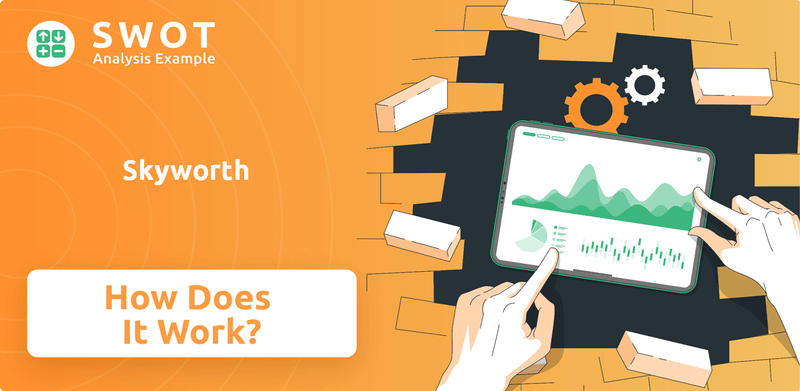
This analysis will explore the Skyworth SWOT Analysis, its diverse revenue streams, and strategic decisions, providing a comprehensive insight into its business model. Delving into Skyworth operations, we'll examine how this company creates value, its competitive advantages, and its outlook within the ever-changing technological environment. Whether you're interested in Skyworth products, Skyworth manufacturing, or the company's financial performance, this exploration offers valuable insights.
What Are the Key Operations Driving Skyworth’s Success?
The core of the Skyworth Company's operations revolves around four main segments, each contributing to its overall value proposition. These segments include smart household appliances, smart systems technology, new energy solutions, and modern services. This structure allows the company to cater to a wide range of customers, from individual consumers to industrial clients.
The Skyworth operations are designed to create and deliver value across diverse markets. The company focuses on innovation, with a strong emphasis on research and development. This approach enables Skyworth to offer cutting-edge products and services, maintaining a competitive edge in the market.
The Skyworth business model is built on a vertically integrated supply chain and advanced manufacturing technologies, which allows for control over quality and costs. The company's commitment to innovation is evident in its extensive patent portfolio and significant investment in research projects. This dedication to R&D translates into customer benefits through advanced features and high-quality products.
This segment includes smart TVs, refrigerators, washing machines, and other appliances. The Coocaa operating system, with a user base exceeding 200 million, enhances the value proposition. The focus is on providing smart home solutions to consumers.
This area encompasses digital set-top boxes, smart gateways, and IoT solutions. Skyworth secured significant contracts, including winning the first place in both bid packages for China Mobile Group's set-top box project in December 2024. This segment also includes spatial computing XR, automotive intelligent display assemblies, and industrial control display modules.
The new energy segment focuses on household distributed photovoltaics, photovoltaics for commercial and industrial use, smart energy management, and energy storage devices. Skyworth has become a leader in this area, contributing to sustainable energy solutions.
This segment provides after-sales service for home appliances, intelligent logistics, park construction and management, financial services, and venture capital investments. It supports the overall customer experience and extends the company's reach.
The company's operational effectiveness comes from its vertically integrated supply chain and continuous investment in research and development. This approach allows Skyworth to maintain quality control and drive innovation. The company's commitment to innovation has resulted in over 14,000 patents filed and more than 200 significant research projects completed.
- Vertically Integrated Supply Chain: Production facilities in Shenzhen and Guangzhou.
- Advanced Manufacturing: Automation and robotics to enhance efficiency.
- R&D Commitment: Over 14,000 patents filed.
- Customer Benefits: Cutting-edge products with advanced AI features and 8K resolution TVs.
Skyworth SWOT Analysis
- Complete SWOT Breakdown
- Fully Customizable
- Editable in Excel & Word
- Professional Formatting
- Investor-Ready Format
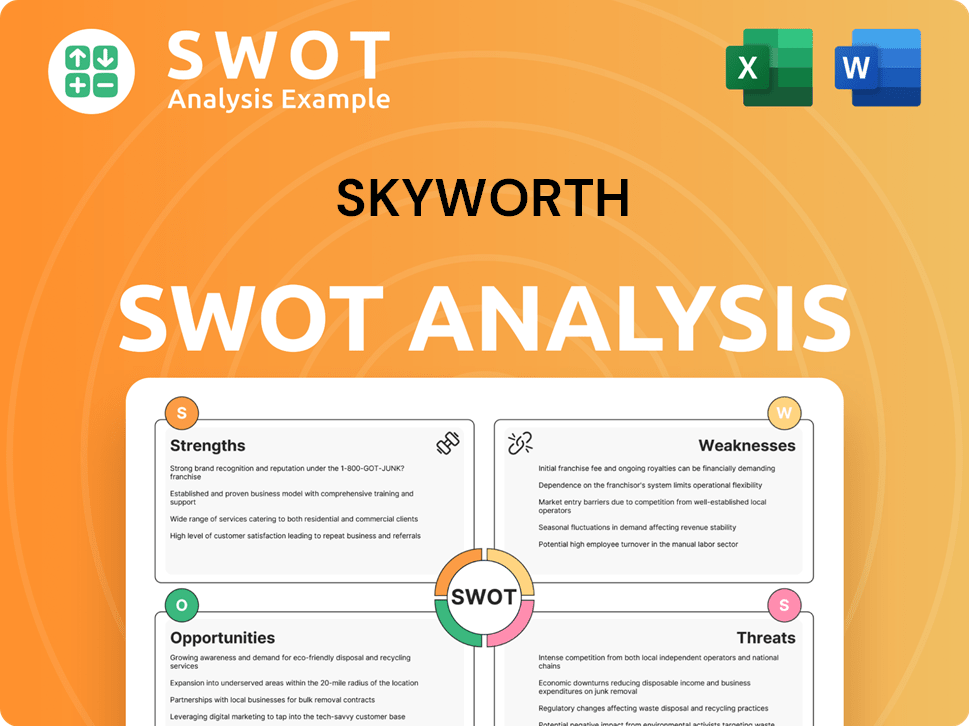
How Does Skyworth Make Money?
The Skyworth Company generates revenue through a diverse range of business segments. These include smart household appliances, smart systems technology, and new energy businesses. The company's financial performance is a key indicator of its overall health and market position.
In 2024, the company's total revenue was RMB 65.013 billion, reflecting a strategic focus on its core business areas. The net profit attributable to owners was RMB 568 million, indicating the company's profitability amidst a dynamic market environment.
The Skyworth operations are supported by several key revenue streams and monetization strategies.
This segment, encompassing smart TV systems and appliances, was the top performer in 2024, contributing RMB 33.469 billion in revenue. This represents a 9.2% year-on-year increase, demonstrating strong consumer demand.
The smart systems technology segment, which includes home access systems and automotive electronic systems, generated RMB 8.511 billion in revenue in 2024. This segment saw an 18.3% decrease.
The new energy business, focused on distributed photovoltaic power stations, generated RMB 20.334 billion in revenue in 2024, experiencing a 13.1% decrease. This reflects the company's efforts in sustainable energy solutions.
This segment includes after-sales service and intelligent logistics. This segment contributes to the overall revenue mix, supporting the company's comprehensive service offerings.
The company employs a variety of monetization strategies, including direct product sales of Skyworth products and internet value-added services through its Coocaa operating system. B2B revenue streams are generated through large-scale procurement projects. The company's global presence contributes to its revenue mix.
The Coocaa operating system, with its large user base, is a key component of the company's monetization strategy. The company focuses on bundled services and tiered pricing for its smart home ecosystem.
The Skyworth business model relies on a combination of product sales, service offerings, and strategic partnerships. The company's ability to adapt to market changes and leverage its diverse revenue streams is crucial for its long-term success. For more insights into the company's ownership and financial structure, read Owners & Shareholders of Skyworth.
- Smart Household Appliances: Strong performance driven by smart TVs and appliances.
- Smart Systems Technology: Revenue decline due to market dynamics.
- New Energy Business: Focus on sustainable energy solutions.
- Monetization Strategies: Product sales, internet services, and B2B projects.
Skyworth PESTLE Analysis
- Covers All 6 PESTLE Categories
- No Research Needed – Save Hours of Work
- Built by Experts, Trusted by Consultants
- Instant Download, Ready to Use
- 100% Editable, Fully Customizable
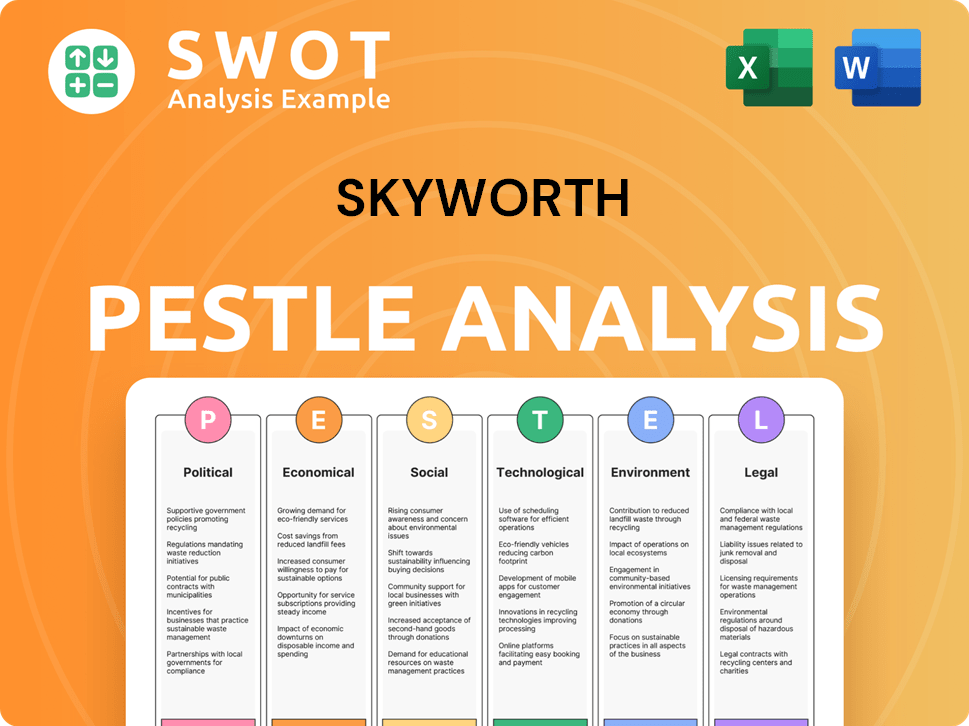
Which Strategic Decisions Have Shaped Skyworth’s Business Model?
The evolution of the Skyworth Company since its inception in 1988 marks a significant journey from a television manufacturer to a diversified technology enterprise. A crucial milestone was its listing on the Shenzhen Stock Exchange in 2000, which facilitated expansion through the injection of RMB 1.18 billion, boosting its presence in both domestic and international markets. This strategic move provided the financial impetus for growth and innovation, shaping its trajectory in the competitive electronics industry.
In recent years, Skyworth operations have been guided by a comprehensive five-year strategy, emphasizing intelligence, refinement, and internationalization. This strategic focus is evident in the company's advancements in AI and IoT integration across its product lines. The commitment to R&D is substantial, with approximately 10% of its total revenue invested in this area in 2022, amounting to around CNY 3.4 billion. The introduction of innovative products, such as 8K resolution TVs with advanced AI features, reflects its dedication to enhancing user experience and staying ahead of technological trends.
Despite facing challenges such as market competition and fluctuations in smart device prices, Skyworth has maintained a strong brand presence and technological leadership. The company's adaptability is highlighted by its involvement in household distributed photovoltaics and its deployment of intelligent vehicle and residential systems. Through multi-dimensional strategies, including product innovation, technological R&D, and brand promotion, Skyworth continues to reshape its competitive edge.
The listing on the Shenzhen Stock Exchange in 2000 was a pivotal moment, raising RMB 1.18 billion and fueling expansion. This financial boost enabled Skyworth operations to scale up production and broaden its market reach. The company's ability to adapt to market changes has been crucial to its sustained growth.
The five-year strategy focused on intelligence, refinement, and internationalization. The company has invested heavily in R&D, approximately 10% of its revenue in 2022, to develop advanced products. This strategy has led to the introduction of innovative products and features.
Strong brand recognition and technological leadership, with over 14,000 patents filed, are key advantages. Its vertically integrated supply chain and advanced manufacturing technologies provide economies of scale. Skyworth Company is also adapting to new trends, such as household distributed photovoltaics.
In 2024, the company faced challenges, including a drop in sales unit price of smart devices. Despite these headwinds, Skyworth responded by strengthening corporate governance. The company continues to adapt and reshape its competitive edge through multi-dimensional strategies.
Facing market challenges, Skyworth has strategically focused on strengthening its core competencies and expanding its market presence. The company has been proactive in adapting to shifts in the industry and has shown resilience in navigating the competitive landscape. For a deeper dive into how Skyworth stacks up against its rivals, consider reading about the Competitors Landscape of Skyworth.
- Focus on AI and IoT integration to enhance product offerings.
- Investment in R&D to maintain technological leadership.
- Strategic partnerships to expand market reach.
- Adaptation to changing consumer preferences and market dynamics.
Skyworth Business Model Canvas
- Complete 9-Block Business Model Canvas
- Effortlessly Communicate Your Business Strategy
- Investor-Ready BMC Format
- 100% Editable and Customizable
- Clear and Structured Layout
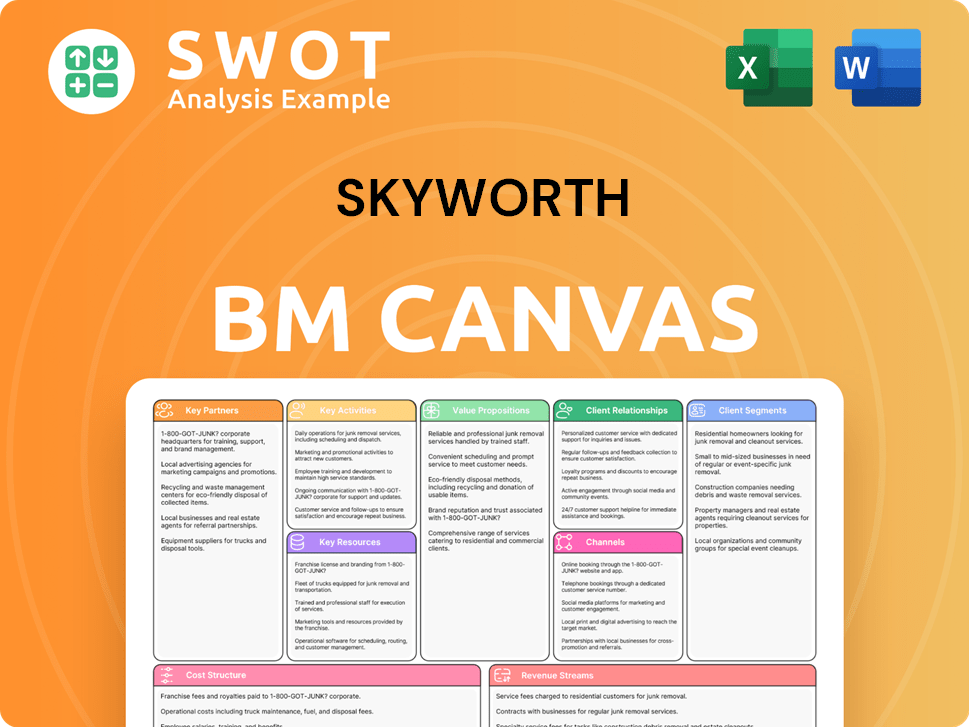
How Is Skyworth Positioning Itself for Continued Success?
The Skyworth Company maintains a strong position within the global consumer electronics and smart technology sectors. As of 2023, it held the third position in China's TV market. Its global presence spans across China, Asia, the Americas, Europe, and Africa, with products sold in over 100 countries as of 2022. Its business model is focused on enhancing consumer experience through advanced technology and sustainable practices.
Several risks and challenges could impact Skyworth operations. These include intense market competition, which has led to lower prices and reduced profit margins. Additionally, the real estate market's downturn in China has necessitated impairment provisions impacting profitability. Regulatory changes and technological disruption also pose ongoing challenges to the company. To understand more about the company's origins, you can read a brief history of Skyworth.
Skyworth is a major player in the consumer electronics market, particularly in the TV sector. Its market share in China and its global reach highlight its significant industry presence. It competes with other major brands in the smart technology space.
Key risks include the highly competitive market, which affects pricing and profitability. The real estate market's performance in China also impacts the company. Regulatory changes and rapid technological advancements pose ongoing challenges for Skyworth.
Skyworth is pursuing strategic initiatives to sustain and expand its revenue generation. The company is focused on advancing three major projects and aims to be a leader in smart appliances. The company is also leveraging AI for product upgrades.
Skyworth is forecast to grow earnings and revenue by 17.4% and 3.2% per annum, respectively. EPS is expected to grow by 18% per annum. The company plans to continue its focus on product innovation, technological research and development, industrial synergy, and brand promotion to drive progress in the new AI era.
Skyworth is committed to several strategic initiatives to drive future growth and maintain its competitive edge. These initiatives include expanding its manufacturing capabilities and leveraging AI technologies.
- Advancing the construction of three major projects.
- Becoming a leader in smart home appliances and IT.
- Using AI to enhance its product range.
- Focusing on product innovation, technological research and development, industrial synergy, and brand promotion.
Skyworth Porter's Five Forces Analysis
- Covers All 5 Competitive Forces in Detail
- Structured for Consultants, Students, and Founders
- 100% Editable in Microsoft Word & Excel
- Instant Digital Download – Use Immediately
- Compatible with Mac & PC – Fully Unlocked
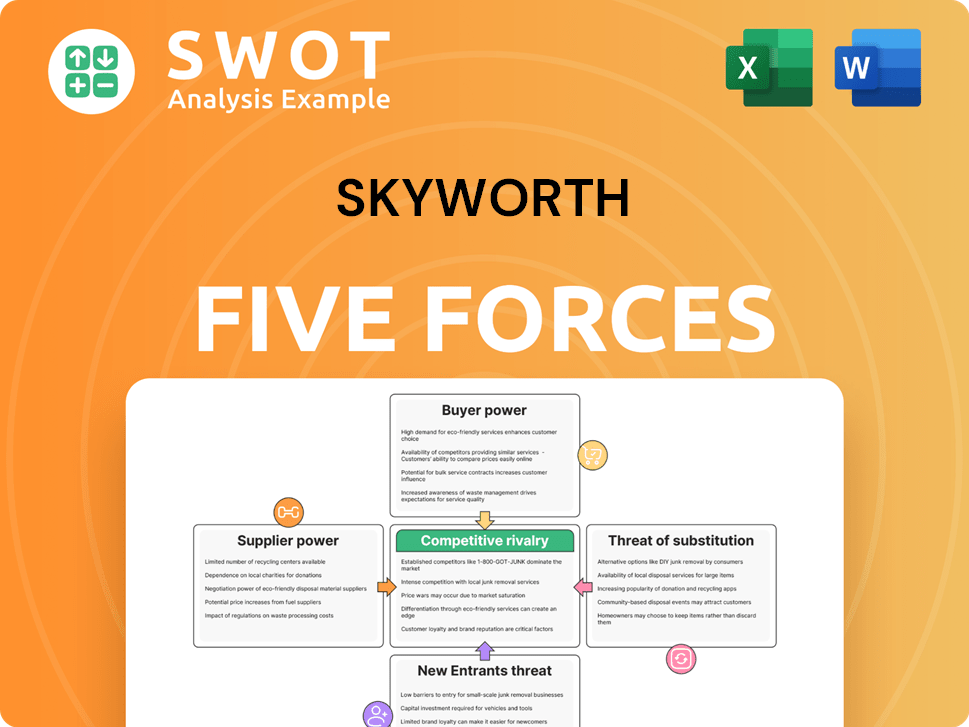
Related Blogs
- What are Mission Vision & Core Values of Skyworth Company?
- What is Competitive Landscape of Skyworth Company?
- What is Growth Strategy and Future Prospects of Skyworth Company?
- What is Sales and Marketing Strategy of Skyworth Company?
- What is Brief History of Skyworth Company?
- Who Owns Skyworth Company?
- What is Customer Demographics and Target Market of Skyworth Company?
Disclaimer
All information, articles, and product details provided on this website are for general informational and educational purposes only. We do not claim any ownership over, nor do we intend to infringe upon, any trademarks, copyrights, logos, brand names, or other intellectual property mentioned or depicted on this site. Such intellectual property remains the property of its respective owners, and any references here are made solely for identification or informational purposes, without implying any affiliation, endorsement, or partnership.
We make no representations or warranties, express or implied, regarding the accuracy, completeness, or suitability of any content or products presented. Nothing on this website should be construed as legal, tax, investment, financial, medical, or other professional advice. In addition, no part of this site—including articles or product references—constitutes a solicitation, recommendation, endorsement, advertisement, or offer to buy or sell any securities, franchises, or other financial instruments, particularly in jurisdictions where such activity would be unlawful.
All content is of a general nature and may not address the specific circumstances of any individual or entity. It is not a substitute for professional advice or services. Any actions you take based on the information provided here are strictly at your own risk. You accept full responsibility for any decisions or outcomes arising from your use of this website and agree to release us from any liability in connection with your use of, or reliance upon, the content or products found herein.